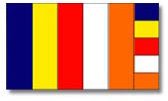Wednesday, May 10, 2006
Knowing the Buddhist flag
The first five stripes of the flag are of five colours.

The sixth colour is a conglomeration of the five, but for the design, it has been separated into its constituent colours.
The Buddhist flag, first hoisted in 1885 in Sri Lanka, is a symbol of faith and peace used throughout the world to represent the Buddhist faith.
The six colors; Blue (nila), Yellow (pita), Red (lohita), White (odata), Scarlet (manjestha), and the mixture of these six colors (prabaswara) of the flag represent the colors of the aura that emanated from the body of the Buddha when He attained Enlightenment under the Bodhi Tree.
The Horizontal Stripes represent the races of the world living in harmony and the Vertical Stripes represent eternal world peace.
The colors symbolize the perfection of Buddhahood and the Dharma.
The Blue light that radiated from the Buddha's hair symbolizes the spirit of Universal Compassion for all beings.
The Yellow light that radiated from the Buddha's epidermis symbolizes the Middle Way which avoids all extremes and brings balance and liberation.
The Red light that radiated from the Buddha's flesh symbolizes the blessings that the practice of the Buddha's Teaching brings.
The White light that radiated from the Buddha's bones and teeth symbolizes the purity of the Buddha's Teaching and the liberation it brings.
The Orange light that radiated from the Buddha's palms, heels and lips symbolizes the unshakable Wisdom of the Buddha's Teaching.
The Combination Color symbolizes the universality of the Truth of the Buddha's Teaching. (Burmese Buddhist replaced with Pink.)
Regardless of race, nationality, division or color, all sentient beings possess the potential of Buddhahood.
The colonel's flag later came to symbolize the unity of Buddhists.
Thereafter, it has been used worldwide and has been used in nearly 60 countries during Buddhist festive seasons, particularly during the Vesak celebrations.
Colonel Olcott was one of the greatest American Buddhists who dedicated his later life entirely to the people of Asia. He is known as the father of the Buddhist education movement since he initiated the establishment of close to 400 Buddhist schools and colleges in Sri Lanka.
